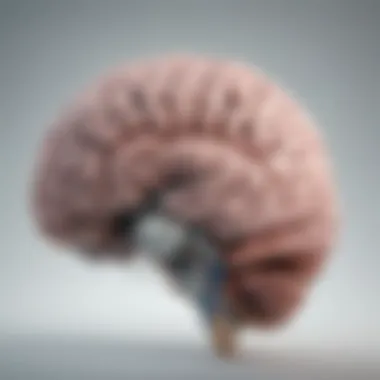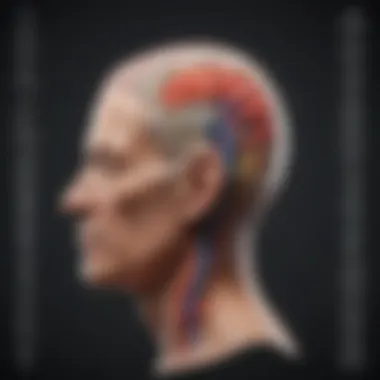Understanding the Causes of Aphasia


Intro
Aphasia is a multifaceted language disorder that affects communication abilities. It is often linked to brain damage, resulting in challenges with speaking, understanding, reading, or writing. This condition is not a reflection of intellect. Rather, it is fundamentally tied to neurological impairments. A proper understanding of its etiology is crucial for both diagnosis and effective treatment.
This exploration begins by examining the various causes of aphasia. We analyze how specific brain injuries, strokes, and neurodegenerative diseases contribute to the disorder. Additionally, psychosocial factors and the necessity for individualized therapeutic approaches are discussed. The goal of this section is to set the stage for a deeper inquiry into the nuances of aphasia and its origins, providing a roadmap for the subsequent analysis.
Prelims to Aphasia
Aphasia is a significant topic in the field of neurology and language studies. Understanding aphasia is crucial for several reasons. First, it helps in identifying the types of neurological conditions that lead to language impairments. Addressing these conditions directly influences diagnosis and treatment options available to affected individuals.
The mechanisms behind language support systems in the brain can become disrupted due to various causal factors. Recognizing these disruptions aids researchers and professionals in developing effective rehabilitation techniques for patients. More importantly, the article will analyze how aphasia impacts both individuals and their families, shaping not just communication, but also emotional and psychological dimensions of life.
Knowledge of aphasia extends beyond clinical importance. It contributes to broader public awareness, education, and support for those who experience this condition. Thus, an informed population fosters a better understanding of the nuances involved in designing effective treatment and support mechanisms.
Definition of Aphasia
Aphasia is defined as a disorder that results from damage to the areas of the brain responsible for language. This damage can affect one's ability to speak, comprehend speech, read, and write. Aphasia is not related to intelligence; rather, it is a communication disorder stemming from neurological injury.
The severity and specifics of aphasia can vary widely. Some individuals may experience mild issues in just one area of language, while others may find they can no longer communicate at all. There are different types of aphasia, each characterized by particular impairments in language skills.
Prevalence and Impact
Aphasia affects approximately 1 million people in the United States alone, with thousands of new cases occurring annually, often associated with stroke or brain injury. The prevalence is notably high among older adults due to the aging population and the increased risk of neurological diseases.
The impact of aphasia is profound, affecting not only communication but also social interactions, mental health, and quality of life. Individuals with aphasia may struggle with feelings of isolation and frustration. The implications extend beyond the person with aphasia; family members and caregivers also face challenges as they navigate new ways of communication and support.
"Aphasia influences daily interactions and can alter relationships long after the underlying cause is addressed."
Moreover, understanding the prevalence and impact of aphasia emphasizes the need for effective public health strategies and policies to ensure that individuals receive the support they need. This awareness can motivate research for new communication technologies and therapeutic approaches designed to assist those with aphasia in restoring their language abilities.
Overview of Etiology
Understanding the etiology of aphasia is fundamental to grasping its complexities. The causes behind aphasia are varied and can arise from distinct neurological conditions. By examining these causes, one can not only understand the specific language impairments that occur but also gain insight into possible therapeutic interventions.
The Role of Neurology
Neurology plays a crucial role in the etiology of aphasia. Various conditions affecting the brain can lead to this disorder. Stroke is a primary culprit, where either a blockage or bleeding disrupts blood flow to critical language areas in the brain. Ischemic strokes result from clot formation, while hemorrhagic strokes occur due to bleeding, both potentially leading to significant damage.
Another neurological cause includes traumatic brain injuries, which can arise from falls, accidents, or direct impacts. Such injuries can lead to different forms of aphasia depending on the affected brain regions.
Furthermore, brain tumors can exert pressure on language centers, disrupting normal function. Different types of tumor, whether benign or malignant, can bring about varying degrees of aphasia.
Lastly, neurodegenerative diseases such as Alzheimer's disease and frontotemporal dementia, progressively damage the brain, impacting language abilities. Each of these neurological causes underscores the complexity of aphasia’s etiology. Understanding them is vital for accurate diagnosis and effective treatment.
Differences Between Types of Aphasia
Aphasia is not a one-size-fits-all condition. There are distinct types, each arising from unique neurological backgrounds. Broca's aphasia, for instance, results from damage to the frontal lobe, leading to difficulties in language production. Individuals often understand language well but struggle to articulate words.
In contrast, Wernicke's aphasia occurs from damage to the temporal lobe, affecting comprehension. People with this condition may speak in long, rambling sentences that lack meaning.
Another variant is global aphasia, which entails a significant impairment in both comprehension and production of language, typically resulting from extensive damage across language areas.
Recognizing these differences is essential. Treatment strategies may vary based on the type of aphasia, demands of rehabilitation, and the individual’s unique context.
Understanding the distinct types of aphasia is fundamental for tailored rehabilitation and effective communication strategies.


Neurological Causes
Understanding the neurological causes of aphasia is paramount to grasping how various physical conditions can affect language capabilities. Aphasia often arises from damage to specific areas of the brain, particularly those involved in language processing. Identifying these causes allows for targeted interventions and better comprehension of the disorder's complexity. Among neurological conditions, strokes, traumatic brain injuries, brain tumors, and neurodegenerative diseases stand out as significant contributors to aphasia.
Stroke
A stroke occurs when the blood supply to the brain is interrupted. This interruption leads to cell death and can have various effects on cognition and language. There are two primary types of strokes involved in aphasia: ischemic and hemorrhagic.
Ischemic Stroke
Ischemic strokes are caused by blockages in blood vessels leading to the brain. This blockage can occur due to a blood clot or a buildup of fatty deposits. The key characteristic of ischemic strokes is that they account for about 87% of all strokes. Their contribution to aphasia becomes evident as affected areas linked to speech and language, particularly in the left hemisphere, suffer from reduced blood flow. This is a major focus of the article because understanding ischemic strokes helps elucidate common pathways that lead to language impairments.
The unique feature of ischemic strokes is the possibility for some recovery if treated promptly. However, delayed intervention can result in permanent damage and long-lasting aphasia. Hence, immediate medical attention is crucial in mitigating potentially devastating language impairments.
Hemorrhagic Stroke
Hemorrhagic strokes occur when a blood vessel ruptures, leading to bleeding in or around the brain. This bleeding increases pressure in the area and damages surrounding tissues. A significant characteristic of hemorrhagic strokes is their potential for rapid onset of severe symptoms, making them critical for immediate medical response.
The unique feature of these strokes is that they can be caused by factors like aneurysms or high blood pressure. While they are less common than ischemic strokes, their chance of incurring severe brain damage, including aphasia, is substantial. Understanding this mechanism highlights the differences in treatment strategies and rehabilitation challenges associated with hemorrhagic strokes.
Traumatic Brain Injury
Traumatic brain injury (TBI) represents a wide range of injuries to the brain resulting from external forces, like accidents or violence. This area of study is essential in understanding how brain damage can impact language. Various types of TBIs can lead to different degrees and regions of language impairment.
Types of TBI
Types of TBI can be classified into closed and open injuries. Closed injuries occur without the outbreak of the skull, while open injuries involve a breach. Both types may lead to disturbances in brain function, including language centers. The characteristic of these injuries is that they can create a broad spectrum of symptoms, including aphasia. Understanding the distinctions helps the readers comprehend the varying impacts of TBIs on language capabilities, essential for tailored rehabilitation approaches.
The unique feature of TBIs is their unpredictability; each injury can affect different areas of the brain to varying extents. The advantage of studying TBIs extensively is that tailored interventions can be developed based on the specific damage to the brain region responsible for language processing.
Consequences on Language
The consequences of TBI on language can be profound. Many individuals experience significant challenges with speaking, understanding, or reading. A key aspect of this is that the type and location of the injury often dictate the severity and nature of the aphasia that develops. Understanding these consequences is necessary for designing effective speech therapy interventions. The focus here is on practical pragmatic aspects for rehabilitation that can adapt over time as the individual's needs change.
Brain Tumors
Brain tumors can disrupt normal brain function by compressing surrounding tissues and affecting the pathways involved in language processing. Depending on their location and type, brain tumors can cause varying degrees of aphasia. The growth of tumors may exert pressure on specific language centers, leading to deficits that can manifest differently in each individual.
Neurodegenerative Diseases
Neurodegenerative diseases, such as Alzheimer's and Frontotemporal Dementia, progressively damage brain cells, which can lead to aphasia as a symptom. The hallmark of these diseases is their gradual nature, leading to increasing difficulties in language and communication over time.
Alzheimer's Disease
In Alzheimer’s disease, language impairment often intensifies as the disease progresses. Key characteristics include impaired word retrieval and difficulty understanding complex sentences. Alzheimer's leads to substantial communication challenges, highlighting the critical need for supportive therapies. This disease is a crucial topic in this article because the direct correlation between cognitive decline and language function provides necessary insight for ongoing research.
Frontotemporal Dementia
Frontotemporal Dementia differs from Alzheimer’s in that it primarily affects the frontal and temporal lobes of the brain. The unique feature of this condition is that it can present with distinct alterations in personality and behavior alongside language difficulties. This combination of symptoms is essential for a comprehensive understanding of how language can be affected by neurodegenerative processes.
Psychosocial Factors
The investigation into the psychosocial factors surrounding aphasia offers a nuanced view of how language impairment interacts with emotional and cognitive variables. These factors are significant because they can either exacerbate or alleviate the symptoms of aphasia. Understanding these components is essential for holistic treatment approaches. The interplay between a person's psychological state and their cognitive abilities can offer insights into the management and rehabilitation process.
Cognitive Decline and Language Ability


Cognitive decline significantly affects language ability. Many individuals with aphasia may also exhibit varying degrees of cognitive impairment, which can interfere with their communication skills. Research shows that cognitive deficits in areas such as attention, memory, and executive function often coincide with language difficulties. This connection highlights the systemic nature of language disorders and illustrates the need for comprehensive assessments in therapeutic settings. Clinicians need to evaluate cognitive skills alongside language capabilities to develop effective intervention plans, as this can make a meaningful difference in rehabilitation outcomes.
Mental Health Influences
The mental health status of individuals with aphasia is an essential factor that cannot be overlooked. Psychological conditions such as depression and anxiety often accompany aphasia, affecting the patient’s recovery trajectory. Addressing these mental health issues is crucial for fostering resilience and enhancing communication abilities.
Depression
Depression can have a profound impact on individuals experiencing aphasia. This condition often presents with major characteristics such as persistent sadness, loss of interest in activities, and emotional numbness. The strong link between depression and aphasia is crucial to examine in this article. Depression can reduce motivation and hinder the patient’s ability to engage in therapeutic activities.
Understanding the unique features of depression in the context of aphasia includes recognizing its potential to cloud cognition and exacerbate feelings of isolation and helplessness. By addressing depression in treatment plans, healthcare professionals can create supportive environments that encourage recovery and language skill improvement.
Anxiety
Anxiety also plays a significant role in the lives of those affected by aphasia. It generally manifests through feelings of worry or fear, often about communication and social interactions. The key characteristic of anxiety is its potential to trigger avoidance behaviors, which can lead to further isolation. Within this context, anxiety can hinder an individual's willingness to participate in therapy, directly impacting language recovery.
A notable point of interest is that anxiety can create a cycle of avoidance and frustration for the patient. This awareness is vital for treatment, as clinicians can integrate coping strategies into speech therapy sessions. Addressing anxiety can enable patients to confront their fears and actively participate in rehabilitation.
In understanding psychosocial factors, it becomes clear that effective management of aphasia requires not just a focus on linguistic rehabilitation but also a comprehensive approach that addresses mental health.
Diagnostic Approaches
The diagnostic approaches for aphasia play a pivotal role in identifying the underlying causes and determining effective treatment strategies. Understanding the mechanisms of language impairment can greatly inform rehabilitation processes. Accurate diagnosis not only guides clinical interventions but also aids in tailoring individualized support for patients. Thus, practitioners must employ a combination of neurological examinations and language assessments to comprehensively evaluate an individual's linguistic capabilities.
Neurological Examination
The neurological examination is essential in assessing patients who present with aphasia. This evaluation includes a series of assessments aimed at understanding brain function and detecting any abnormalities. Clinicians often look for signs of neurological damage or disease, which may include weakness or coordination issues. The primary aim is to rule out or confirm potential neurological causes behind the language disorder.
Through a detailed history and physical examination, medical professionals can gain insights into the patient's overall health and the specific types of deficits they might be experiencing. Imaging techniques such as MRI or CT scans may also be employed to visualize brain structures and identify areas affected by injury or disease. This comprehensive approach allows for more accurate predictions regarding recovery and treatment outcomes.
Language Assessments
Language assessments involve a systematic evaluation of a patient's communicative capabilities. These assessments are crucial for understanding the extent and nature of the aphasia. Clinicians commonly utilize two types of assessments: standardized tests and informal assessments.
Standardized Tests
Standardized tests are structured tools designed to measure various aspects of language function in a controlled environment. These tests provide metrics for assessing comprehension, expression, and other linguistic abilities in patients. A key characteristic of standardized tests is their normative data, which enables comparisons between individuals in similar demographics. This feature highlights the severity of the condition, contributing to targeted therapeutic strategies.
These tests are advantageous because they offer reliable, valid results that can be reproduced across different settings. However, they might not capture the full picture of an individual’s language use in natural environments. As such, while they are beneficial for obtaining a baseline understanding, they may need to be supplemented with additional methods for a complete assessment.
Informal Assessments
Informal assessments give a semi-structured approach to evaluating a person’s language skills during natural interactions. This type of assessment includes engaging the patient in conversation, observing their responses, and noting communication effectiveness in real-world scenarios. The primary characteristic that sets informal assessments apart is their flexibility, allowing clinicians to adjust questions based on patient responses.
This approach is particularly beneficial because it provides insights into daily communication challenges, which may not emerge in standardized testing environments. However, the subjective nature can introduce variability and may not always provide conclusive data as standardized methods do. Therefore, it is crucial to weigh the results of informal assessments alongside formal evaluations to establish a comprehensive understanding of the individual's abilities.
A thorough diagnostic process is essential in the effective treatment of aphasia; it combines neurological evaluations and various forms of language assessments for a complete view of the patient’s communicative status.
Treatment and Rehabilitation Strategies
Treatment and rehabilitation strategies are vital components in addressing aphasia. These methods focus not only on improving language abilities but also on enhancing the overall quality of life for individuals with aphasia. A tailored approach ensures that therapy meets the specific needs of the patient, accommodating various types of aphasia and their unique manifestations. As the impact of aphasia can be profound, effective treatment is essential in fostering communication, social integration, and emotional well-being.
Speech Therapy
Individualized Therapy Plans


Individualized therapy plans are central to the success of speech therapy for individuals with aphasia. These plans are customized based on thorough assessments, which take into account the patient's specific language deficits, strengths, and personal goals. A key characteristic of individualized therapy is its focus on personalized goals, which motivates patients and enhances their commitment to the rehabilitation process.
One of the unique features of these plans is that they incorporate various techniques and tools tailored to the patient’s needs, such as visual aids or technology-assisted communication devices.
The benefits of individualized therapy plans lie in their targeted approach. Patients often respond better when they see the therapy is relevant to their lives. However, this method requires constant assessment and may involve more resources, such as time and specialized personnel, which can be a limitation in some settings.
Group Therapy Sessions
Group therapy sessions provide a different but equally important avenue for treatment. These sessions often foster a sense of community and shared experience among participants, helping to reduce feelings of isolation. A key characteristic of group therapy is its interactive nature, where patients can practice communication skills in a supportive environment.
The unique feature of group therapy lies in the social interaction that it promotes. Participants can learn from each other’s experiences and practice language skills in real-time conversations. This setting not only enhances language abilities but also boosts confidence as individuals share their journeys.
The advantages of group therapy include the encouragement it offers and the opportunity to experiment with language in a less pressured setting. However, it might not be suitable for everyone. For some individuals with severe aphasia, group dynamics can be overwhelming, and their specific needs might not be adequately addressed.
Role of Family Support
Family support is a critical element in the rehabilitation of individuals with aphasia. The emotional and practical assistance from family members can enhance the effectiveness of treatment strategies. Family involvement can lead to better outcomes by reinforcing communication exercises at home and providing a familiar environment for practice.
Support networks often play an important role in encouraging positive habits and emotional resilience, which are crucial for recovery. Families can also benefit from education about aphasia, helping them understand the challenges and effects of the condition, which fosters empathy and patience.
Implications for Future Research
Understanding the implications for future research on aphasia is essential for several reasons. As the field continues to evolve, identifying gaps in current knowledge can lead to advancements in both treatment and understanding of this language disorder. Research initiatives can greatly impact how aphasia is diagnosed, treated, and understood within the context of the broader neurological landscape.
Specific elements that warrant further exploration may include innovative therapies and their effectiveness. Currently, evidence-based practices play a pivotal role in treatment methods, but exploring alternative strategies may yield beneficial results for patients. Additionally, areas such as the impact of technology on language rehabilitation need investigation. Digital tools and applications offer new ways to assist individuals in regaining their language abilities. Understanding how these emerging technologies can be effectively integrated into therapeutic frameworks may also open new possibilities in aphasia treatment.
Benefits of future research in aphasia include the potential for improved outcomes for affected individuals. Such research can lead to more personalized and effective intervention strategies. For example, unraveling the specific mechanisms behind various types of aphasia can aid practitioners in creating tailored rehabilitation programs. Furthermore, studies focused on understanding the psychosocial implications of aphasia can shed light on the mental health aspects — contributing to a holistic approach to treatment that addresses both language and emotional needs.
Considerations about future research include ethical practices, funding availability, and collaboration across disciplines. Engaging various stakeholders such as neurologists, speech-language pathologists, and mental health professionals will help in gaining comprehensive insights. Moreover, longitudinal studies will be crucial in understanding the progression of aphasia over time, facilitating the development of strategies that evolve with the patient's needs.
"Future research holds the key to unlocking new treatments and enhancing the quality of life for those with aphasia."
In summary, highlighting the implications for future research on aphasia is vital for advancing knowledge and improving treatment practices. As investigations continue, they promise to illuminate pathways for more personalized and impactful therapies that address the multifaceted nature of this disorder.
Emerging Treatments
The development of emerging treatments in aphasia requires constant attention to new findings and methodologies. Traditional methods, while effective, often need to be complemented by innovative approaches. For instance, neuromodulation techniques are being explored to enhance language recovery. Several studies indicate that non-invasive brain stimulation methods can facilitate neuroplasticity, potentially leading to improved language skills for patients.
Additionally, virtual reality and augmented reality applications are being investigated as tools for speech therapy. These technologies can create immersive environments for patients, making practice more engaging and potentially more effective. Understanding how patients respond to these emerging treatments will require rigorous testing and validation.
Longitudinal Studies
Longitudinal studies play an important role in aphasia research. They allow researchers to track changes in language ability and cognitive function over time. By observing how patients progress, researchers can identify patterns and factors that contribute to recovery or deterioration. This information is crucial in refining therapeutic approaches and understanding the long-term implications of aphasia.
Furthermore, these studies can illuminate the psychological impact of living with aphasia. Investigating the emotional and social challenges faced by individuals over months or years can inform holistic treatment plans that consider both language re-acquisition and mental well-being.
Ending
Understanding the etiology of aphasia is a critical component in both diagnosis and treatment. This article has explored various causes that lead to this complex disorder, offering insights into the implications for those affected. The multifaceted nature of aphasia requires an integrative approach that considers not only neurological damage but also psychosocial factors that can exacerbate or contribute to language impairment.
Recap of Key Points
In summary, the key points addressed throughout the article are as follows:
- Defining Aphasia: We established what aphasia is and its impact on communication.
- Neurological Origins: Strokes, traumatic brain injuries, and neurodegenerative diseases were highlighted as primary causes.
- Psychosocial Elements: Mental health and cognitive decline play significant roles in the manifestation of aphasia.
- Diagnostic Approaches: Standardized and informal assessments were discussed for understanding individual language capabilities.
- Treatment Options: Individualized therapy plans, combined with family involvement, are essential for effective rehabilitation.
- Research Directions: We concluded by discussing emerging treatments and the need for longitudinal studies to enhance understanding.
Final Thoughts on Aphasia Etiology
In the landscape of neurological disorders, aphasia remains a complex yet pivotal area of study. The interplay of biological, social, and psychological factors necessitates a holistic understanding when seeking effective solutions. As research evolves, there is much to be hopeful for in treatment advancements.
The necessity for individualized care is paramount. Each person’s experience with aphasia can vary greatly, emphasizing the importance of tailored rehabilitation strategies. Moreover, ongoing discussions in professional communities can lead to a more profound understanding of how to tackle the barriers posed by aphasia.







